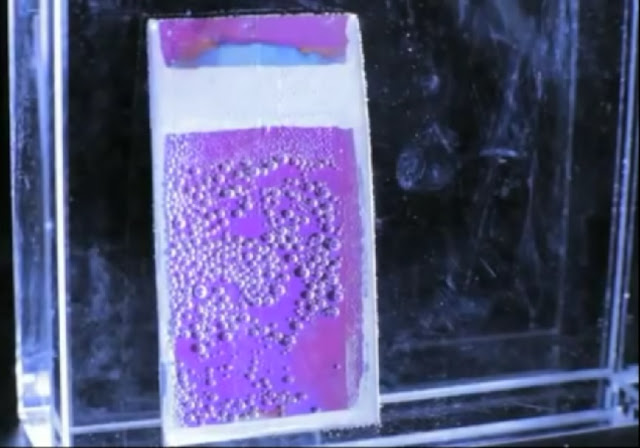Artificial Leaf – for Hydrogen Production
According to U.S. Energy Information Administration, the estimated oil reserve is 1-4 trillion barrels (2015) and with the current rate of consumption of the crude oil (estimated 25 billion barrels per year) the reserve may end in 50 years. With this, the search for the alternate fuel begun. In the search for the fuel with good calorific value and less greenhouse emission scientists have focused on using Hydrogen as an alternate fuel. Hydrogen as a fuel is used for various applications. At present, the production of Hydrogen for using it as a fuel is not very eco-friendly process, as it is produced from the fossil fuels by steam reforming. This process of steam reforming emits a large amount of Carbon dioxide, which is a greenhouse gas and promotes global warming.
Figure: Image showing the bubbles of Hydrogen gas evolution from the artificial leaf.
The production of Hydrogen by the conversion of the light energy to the Chemical energy artificial Photosynthesis in leaves is a very a promising approach but at the same time, it is a very complex process which is very difficult to achieve. Very recently is a research published in Scientific reports, open-access journal from the publishers of Nature,”Possibly scalable solar hydrogen generation with quasi-artificial leaf approach”, the scientists from CSIR-National Chemical Laboratory (CSIR-NCL) made an attempt to generate solar hydrogen. They made an artificial leaf that absorbs sunlight to generate hydrogen fuel from water. The device consists of an assembly of the Semiconductors which are stacked over each other in order to simulate the natural leaf system. It has an area of 23 sq. cm. This research focused on using AuNPs as a plasmonic sanitizer along with PbS/CdS QDs for designing wireless photochemical cell at no applied potential. It was also demonstrated that the quasi-artificial leaf in wireless configuration harvests the solar light and converts it to Hydrogen effectively than the wired configuration. When visible light strikes the semiconductors, electrons move in one direction, producing electric current. It can produce 6 liters of Hydrogen fuel per hour. The current produced almost instantaneously splits water into hydrogen- which can be used as a fuel cell.




No comments